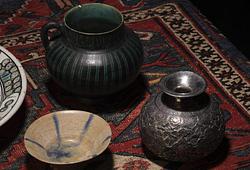Anna Petrus
An Anna Petrus pewter mirror, Svenskt Tenn, Sweden 1929.
Makers's mark Stockholm C8 (1929), 56 x 38,5 cm.
The crest re-soldered to the frame.
Kirjallisuus
Monica Eriksson, 'Svenskt tenn från Svenskt Tenn', essay, Stockholm University 1985, p 58, ill 33, see the interior from the the showroom at Strandvägen, Stockholm 1927, p 79, ill 52, interior from the showroom at Strandvägen in the early 1930's, see the model in the left corner.
Hedvig Hedqvist, Rikard Jacobson & Jan von Gerber, 'Modernt Svenskt Tenn', Atlantis 2004, compare a variant of the model illustrated p 26. The mirror is one of Anna Petrus first models designed for Svenskt Tenn.
Marie Rehnberg, "Anna Petrus Skulptör och Industrikonstnär", Bokförlaget Signum 2009. Pp 96, 100.
Muut tiedot
Anna Petrus (1886-1949) was an educated sculptor, a graphic artist as well as a designer of works of art. She designed cast iron objects for Näfveqvarns Bruk that were shown at The Paris 1925 Exhibition. She collaborated with Estrid Ericson and Svenskt Tenn between 1926-28 which as a result gave us a line of objects that have been in the Svenskt Tenn production ever since they were designed, on many of them the lion is a predominant decoration and the lion has become more or less a signature of Anna Petrus' designs.






















































